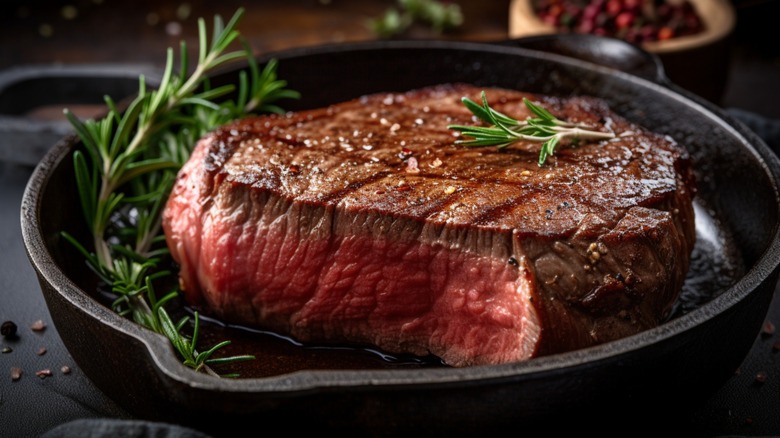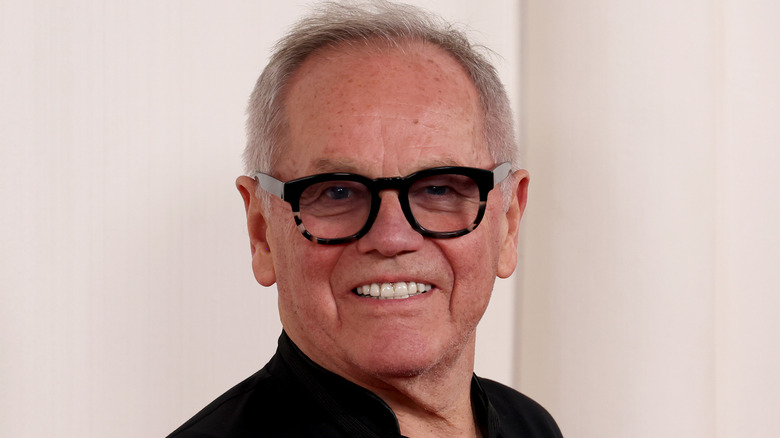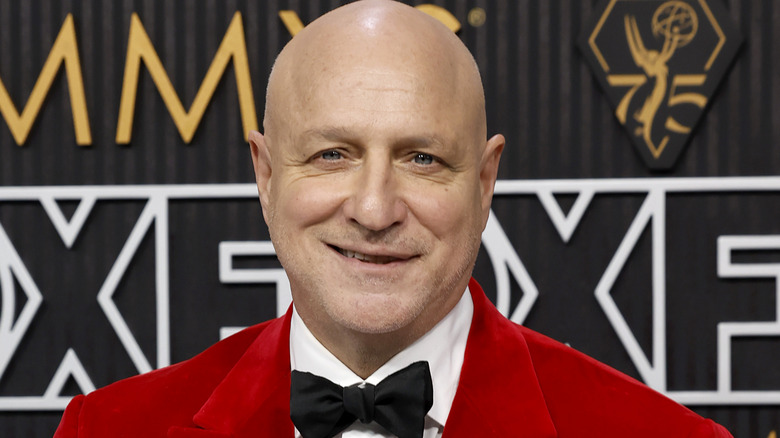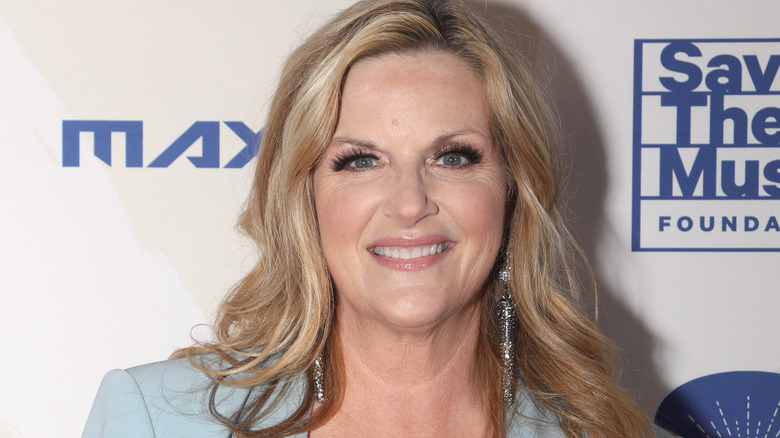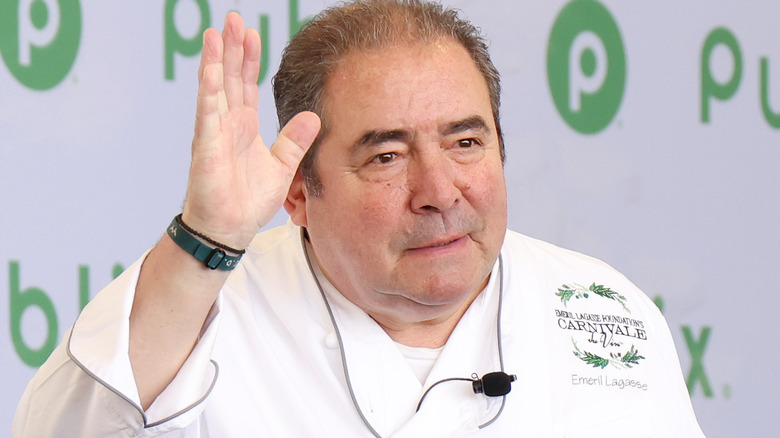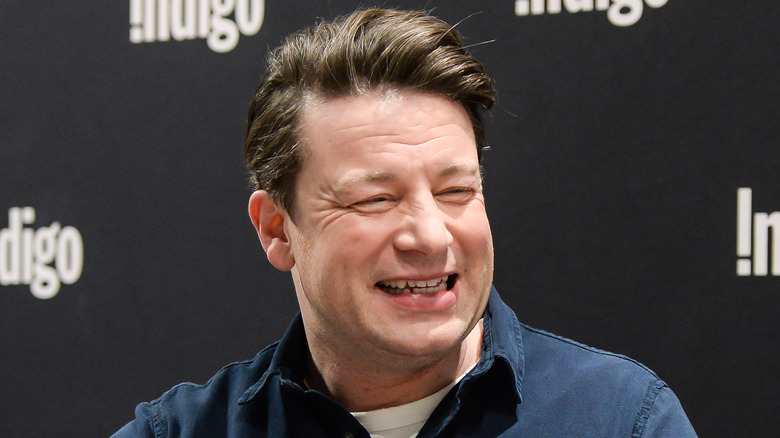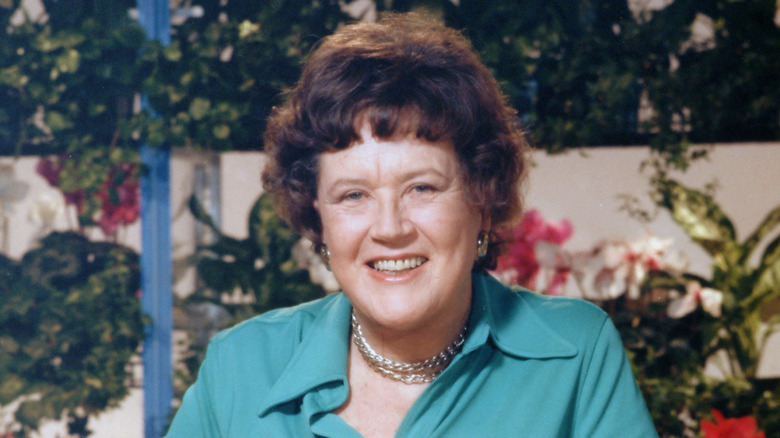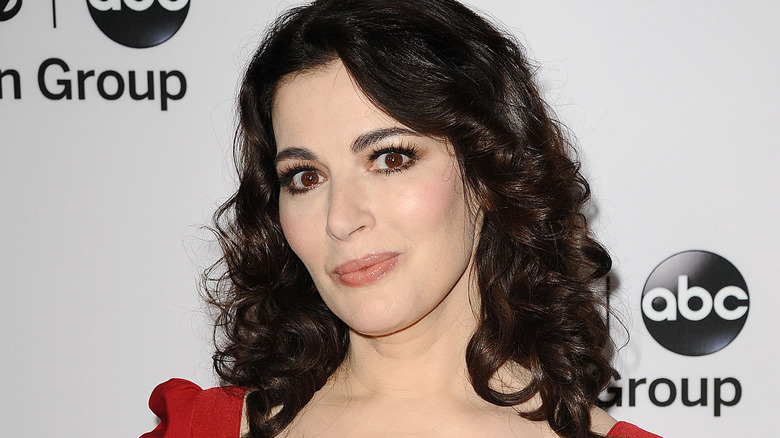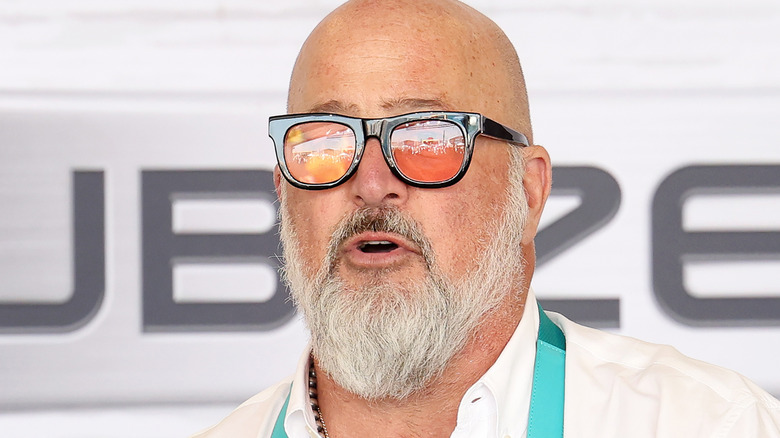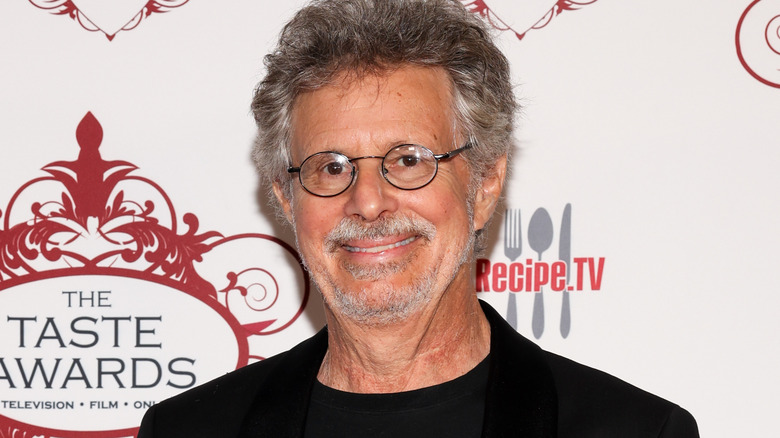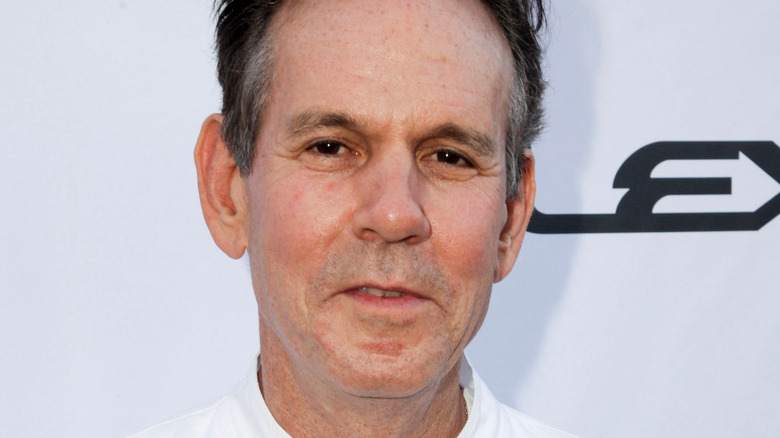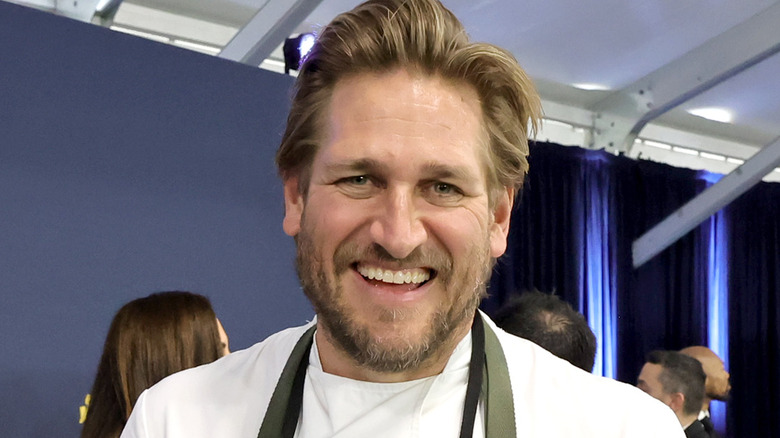How Celebrity Chefs Really Like To Order Their Steak
It's practically a universal opinion that a nice steak, prepared in an old-fashioned, service-minded, and expensive steakhouse, is the ideal dining experience — even for celebrity chefs with strong opinions about food. Steak is a simple dish consisting of a particular cut of beef with some light seasonings. This means the relative quality of a steak is based largely on preparation, and that's also a matter of preference. There are only so many ways a steak can be cooked and only so many ways it can turn out — well-done, medium, and rare (and its variants), which all refer to the temperature of the meat and the ribbon of pink in the center.
Chefs and celebrity cooks are food experts, and they've developed legitimate and well-thought-out feelings about steak, honed across years of cooking professionally and dining well. While one might assume that they all prefer their steak on the rare side (because that's where the distinct flavors of meat seemingly sing the loudest), it's not always the case. Here's what a wide variety of celebrity chefs tell their servers when they want what they consider to be the perfect steak.
Wolfgang Puck
One of the late 20th century's most admired chefs, Wolfgang Puck opened Spago in West Hollywood in 1982. Puck has since opened many more restaurants in the U.S. and around the world, including CUT, a steakhouse in Beverly Hills.
His top choice for a steak is the porterhouse because it consists of both a tenderloin and a strip steak (though he prefers the New York half, aka the strip). CUT fires up its steaks (which have been allowed to reach room temperature, seasoned on both sides, and rubbed with olive oil) on a grill over charcoal and wood. "I like mine rare," Puck said in a TikTok video. To get the outer sear that he likes, Puck explained in another TikTok clip that he makes sure that the heat is turned up as high as possible. "I want to sear the steak, so it gets a good crust, and then finish it slow," he shared.
Tom Colicchio
Tom Colicchio, the longtime "Top Chef" judge and restaurateur behind Craftsteak, says that the kind of steak, its origins, preparation, and fat content are far more important elements to pay attention to than the level of doneness. "A steak needs fat to taste great," he told Allure. "My favorite cut, a strip steak, has the best marbling (which is fat running through the meat), and that gives it a richer flavor and texture," he added, also recommending a porterhouse for two because it affords the chance to enjoy a strip steak as well as a filet. Whenever possible, Colicchio prefers grass-fed, USDA-certified prime beef.
As far as the cooking method goes, Colicchio doesn't like grilled steak. "That tends to dry it out, and I find grill marks leave a bitter taste," he said. "A good steakhouse will offer different options for preparation, and I would ask them to broil or pan-roast the steak and finish it with butter." That makes for a juicy steak that Colicchio thinks is best when cooked medium-rare, or "warm and red in the center."
Trisha Yearwood
Country music superstar Trisha Yearwood isn't a trained chef. Nevertheless, she has parlayed her enjoyment of food and a special recipe that keeps her connected to her late dad into a line of cookbooks (including "Home Cooking with Trisha Yearwood") and the Food Network series "Trisha's Southern Kitchen."
Yearwood toured extensively as a musician, and once, her travels took her to Portland, Oregon, where she dined at a restaurant called Jazz de Opus. "I had one of the best steaks in my life," Yearwood recalled to Bon Appétit. Jazz de Opus even prepared it to the temperature of her choice, which she knows is controversial among cooks and chefs. "I like a well-done steak, but I know kitchens hate to make it," she said. Yearwood enjoyed her unconventional idea of an ideally prepared steak at Jazz de Opus, which came out well-done, cooked all the way through with no pink meat in the middle. "What they did was they baked it for a while before grilling it, so it was completely done, but it was tender," she explained.
Emeril Lagasse
Emeril Lagasse is best known for his traditional and contemporary approach to New Orleans cuisine, which he honed at the historic Commander's Palace, where he took over as executive chef in 1982. Following his stint at Commander's Palace, he opened several restaurants of his own, including Emeril's Delmonico, which is among the best steak restaurants in the U.S. if not the most historical. There, under Lagasse's direction, high-quality, dry-aged beef is served.
Lagasse knows his way around a steak, and he demonstrates a premium level of expertise throughout his many published cookbooks and recipes. The chef makes his preference for steak temperature perfectly clear in his prescriptive instructions. Served at Delmonico, Lagasse's recipe for Emeril's Steak Oscar is strictly prepared medium-rare or medium. This command holds true for Lagasse's recipe for New York Strip With Beurre Maître D'hôtel as well. Meanwhile, his Rib Steak, Bordeaux Style is prepared medium-rare.
Jamie Oliver
True to his reputation and well within his wheelhouse, the budget-conscious, flavor-minded host of "Jamie's Money Saving Meals" and "Jamie's £1 Wonders" and author of "Save with Jamie," British chef Jamie Oliver doesn't think an expensive steak is necessarily the best steak. According to his website, Oliver eschews cuts such as ribeyes and filets in favor of his favorite, the feather steak (otherwise known as a flat iron steak) because of its impressive degree of marbling, flavor, and mouthfeel.
That being said, Oliver recommends the same method of preparation for cooking a "perfect steak," regardless of the selected cut. "During cooking, aim to cook your steak medium-rare to medium," he writes. "Turning it every minute or so will make sure you get a really even cook." Resting and a post-cooking oil or butter rub complete the process. Leaving it on the grill for any more than the time it takes to get to a maximum of medium is inadvisable, according to Oliver. "Any more and you'll be left with a tough piece of meat," he explains.
Julia Child
Before Julia Child became a pioneer of public television and cooking shows with her first instructional series "The French Chef" in 1963, she co-authored "Mastering the Art of French Cooking." The book demystified classic French cuisine, making it accessible to home cooks, thereby expanding the palates of millions.
There were many foods Child couldn't stand, but steak wasn't among them. Child developed the standards for many dishes, and in "Mastering the Art of French Cooking," she wrote about the proper way a steak should ideally be prepared and served. In the first edition of the best-selling cooking manual, Child told readers that a steak should be cooked rare, which translates to an internal temperature of 140 degrees Fahrenheit. In 1978, with "Julia Child and Company," Child again called for rare steaks, but to achieve that status with even less time on the heat, she recommended that the beef reach an internal temperature of just 125 degrees Fahrenheit.
Bobby Flay
Bobby Flay is one of the United States' most popular chefs, Food Network stars, and restaurateurs. Flay's impressive portfolio also includes a signature steak.
In a March 2024 video on TikTok, Flay attempted to dispel the conventional wisdom that burgers and steaks taste best if they have been grilled rare with a thick stripe of pink meat in the middle. "If you ask most chefs ... they'll tell you that they want like, rare or medium-rare steaks and burgers. I don't," Flay declared. According to Flay, he likes his burgers to be medium because if the fat doesn't melt, it's not as delicious. "I want the fat to melt so that it actually lubricates the beef itself." And the same goes for Flay's steaks. As he explained, "If you don't cook it and the beef itself is too rare, it's hard to chew."
Nigella Lawson
Nigella Lawson, the British food journalist turned cookbook author and star of such cooking shows as "Nigella Bites," singularly advocates for the enjoyment of food as much as she does the joys of home preparation. When a fan on X, formerly known as Twitter, asked Lawson, "Do [you] eat your steak well done?" the cookbook author and TV host denied anything of the sort, proclaiming that she likes her meat "Black and blue!"
That's a somewhat obscure — but very specific — way to order a steak. "'Black and blue' is the New York restaurateur's term for the way I like my steak cooked: charred on the outside, meltingly, quiveringly rare within," Lawson explains in her book "Forever Summer." This method gives the steak an almost burnt crust that conceals an extremely rare middle that's so reddish-pink it almost looks purple or blue. The final product is obtained by cooking a steak on a grill left to heat up as high as it can go, which scorches the outer surface while barely affecting the inner layers.
Andrew Zimmern
Not every big city's high-end, premiere steakhouse prepares its steaks in the same way. Some use broilers, or they cook them up in a skillet. Manny's Steakhouse in Minneapolis employs a simple, although extremely hot grill to prepare its steaks. It makes for a cut with a thick, black, powerfully bitter but seasoned crust on the outside while ensuring the meat underneath is cooked to its customers' specifications. That's good enough a style to land Manny's on a ranking of the world's best steakhouses, as well as on a list of Andrew Zimmern's personal favorites. Zimmern, chef, food writer, and host of various versions of "Bizarre Foods" for the Travel Channel and "What's Eating America" for MSNBC, told Vanity Fair that Manny's strip steak "is the best piece of meat in town."
The strip steak, perhaps far better than even the best thing Zimmern ever ate on "Bizarre Foods," is the chef's choice among the choicest cuts. He likes his cooked as little as possible and served in a classic steakhouse environment. "I am a carnivore, unashamedly. Nothing beats a steak charred rare," he shares.
Gordon Ramsay
Gordon Ramsay presides over a worldwide food empire that includes dozens of restaurants built on preparing familiar and popular dishes as perfectly as possible. His Gordon Ramsay Steak restaurants deliver top-notch cuts of beef in elegant locales, just the way Ramsay likes. Throughout his decades as a chef, he's developed a step-by-step system to ensure that an ideal product is served at Gordon Ramsay Steak — one that he'd like to eat himself.
A steak good enough for Ramsay and his customers is allowed to sit unrefrigerated for at least 10 minutes before cooking, coated in a thick layer of salt and pepper, and then pan-seared in butter, herbs, and garlic. That perfect steak then rests when it's done cooking, which for Ramsay is when it's medium-rare. "It gives a little bit but is soft enough to understand that it's medium-rare," he explains in a YouTube video titled "Gordon Ramsay's Top 10 Tips for Cooking the Perfect Steak."
Steven Raichlen
Steven Raichlen perhaps knows more about the ins and outs of grilling meat, especially steak, than any other celebrity chef. He's written over 30 books on barbecue, including "The Barbecue Bible," and "How to Grill," and hosted "Barbecue University" years ago.
A great steak, Raichlen believes, starts with a Prime-graded, well-marbled, relatively soft cut, like a porterhouse, ribeye, or strip that's around 1.5 inches thick. And then Raichlen wants his steak cooked at a high heat. "Steakhouses cook at temperatures ranging from 800 to 1200 degrees [Fahrenheit]," he says on his website, noting that they should be charred so they develop a deeply caramelized crust. Raichlen doesn't want a steak fired past an internal temperature of around 130 degrees Fahrenheit. "Rare is 120 degrees; medium-rare is 125 to 135 degrees; meat cooked to 140 degrees and beyond is considered medium-well to well," he writes. "Hopefully, you will not be cooking steaks to these temperatures." (Overcooking is just one of the many mistakes people make when grilling.)
Thomas Keller
Thomas Keller, proprietor of Napa Valley's French Laundry and New York's Per Se, is among the most acclaimed American chefs. It takes a lot to earn a Michelin star, and Keller is the only U.S.-based chef to ever receive three from the Michelin Guide multiple times. Keller is forever on the cutting edge of cuisine, but he still enjoys a steak, albeit one prepared with a relatively new and innovative method.
Keller thinks restaurants ought to experiment more with sous vide preparation, in which food is cooked inside of a bag suspended in water inside a special machine, very slowly and at a low temperature. "It's used for precise, à la minute cooking," Keller explained to Washingtonian. The method leaves a steak at the same level of doneness throughout. "When you order a steak medium, that's the temperature in the very center, but the outside is cooked well done and the next layer is medium-well, et cetera. But with sous vide, that piece of meat is medium from edge to edge," he noted.
Curtis Stone
Meat figures large in the history of chef and TV food host Curtis Stone. Before his culinary training, he worked in a butcher shop and has since launched a line of Angus beef and opened a Los Angeles restaurant and butcher called Gwen.
Stone likes to cook his steaks himself — a ribeye is his preferred cut — on a grill, and in order to get the beef the exact way that he likes it, he uses a careful multi-step process. "I try to cook my steaks for maybe 60 to 90 seconds on either side, and then you can pull it off and let it rest," he tells Us Weekly. Then, five minutes later, he repeats the steps, which he says ensures that the steak turns out the way it's supposed to look — more important than whatever a thermometer might say. "That's how you get that beautiful, even pinkness through your steak, and of course giving it that last rest before cutting into it is really key," he shares.
Michael Symon
Chef, cookbook writer, and long-time Food Network personality Michael Symon thinks that the temperature of a finished steak is important, but he doesn't think its level of doneness is the only relevant factor. For him, the preparation and heat allowance correlates to what type of steak is on offer. "They get caught up into a specific temperature," Symon said about steak aficionados to Tasting Table. "Temperature depends on what steak you're eating."
For example, if Symon plans on grilling a filet, or ordering one in a restaurant, he's careful to account for the low-fat content. "I don't like it cooked past rare," he said. Fattier cuts are a different story. "A ribeye has a lot of intramuscular fat and it tastes best closest to medium, where that fat could melt into the steak and you get the benefits of the fat."
Static Media owns and operates Tasting Table.
